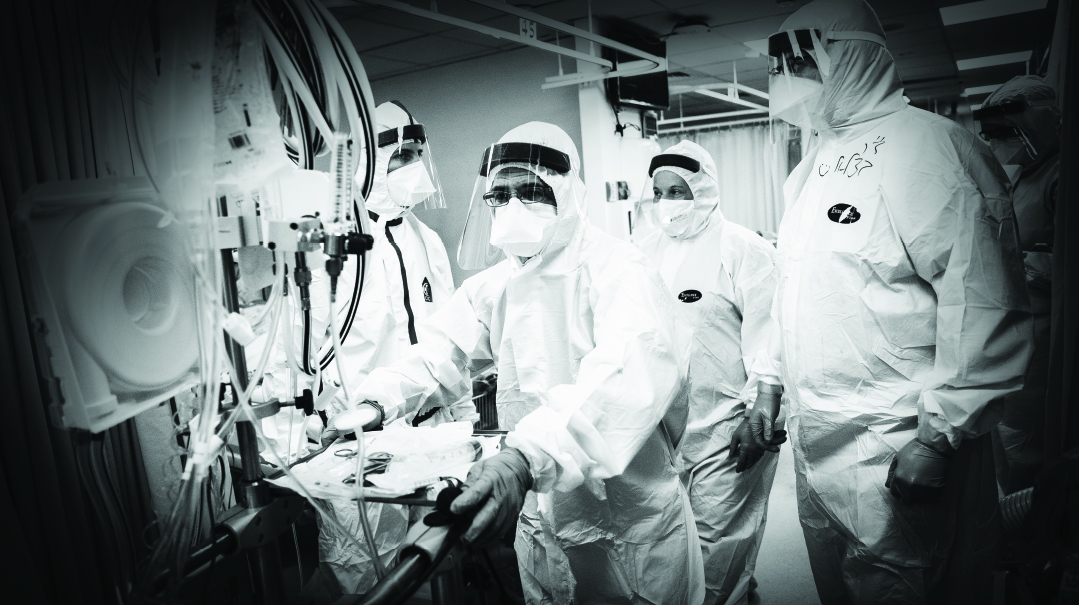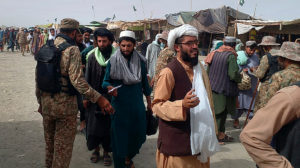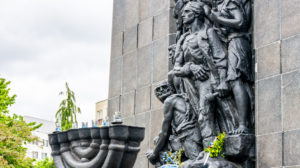Israel’s Corona Third Wave swells to Tsunami

In a country used to conflict, the mounting pressure on medical facilities has some doctors warning of even worse to come

Tragic scenes of young and old suffering, hospitals swamped and medical staff strained to the breaking point by a coronavirus mutation that came from nowhere.
This could be Italy, New York, or London in March 2020, as the COVID tsunami broke across the developed world. But those scenes are actually the reality now in Jerusalem and Bnei Brak, as Israel grapples with its strongest wave yet of the disease. The country shut down so quickly in the first wave last year that it emerged with less than a hundred fatalities; the second wave saw nearly 1,500 deaths by the end of October, a figure still overshadowed by staggering losses elsewhere in the world.
But now, after ten exhausting months of endless lockdowns, economic and social chaos and increasingly restive streets, COVID-19 has hit the country with the same force it hit Western Europe and the US. Last month, 1,300 people died of the virus — nearly half the military deaths of the Yom Kippur War. Nowhere is that crisis more evident than on the front lines of the corona battle, inside Israel’s hospitals.
“We’re at the height of the third wave of COVID-19, which is dwarfing the first two waves,” says Dr. Relli Alon, deputy director of nursing care at Jerusalem’s Hadassah Ein Kerem Medical Center. “There are more cases, more serious cases, more young cases, and more cases among young pregnant women, who can reach critical condition. They have to be separated from their husbands, their children, and even the baby they give birth to, and it’s painful to watch. And a clear majority of those hospitalized in the corona ward are chareidi.”
And in a country used to conflict, the mounting pressure on medical facilities has some doctors warning of even worse to come.
“The overflowing hospitals are reminding me of Italy, but we don't choose who we treat,” says Professor Eliyahu Sorkin, head of the corona ward and ICU of Mayanei Hayeshuah Medical Center in Bnei Brak. “This is a war.”
Fighting back tears
Dr. Relli Alon has been in Hadassah Ein Kerem’s corona ward for over three hours, in white overalls, a mask, overshoes, and gloves by the time we speak. Medical teams are requested not to stay in the ward for over two hours at a time, due to the stifling, cumbersome protective clothing. But there’s a lot of work to be done, and time is short.
“I’m realizing that I didn’t even have time to drink a sip of water,” she says as she leaves the ward.
It was a tough shift, physically and emotionally. We watched as they performed resuscitations on two patients, each lasting 40 minutes. Neither patient made it. Minutes later the same teams were comforting an ailing patient, filling the role of sympathetic family members. We saw them smile slightly when one patient was able to rise to his feet, after being bedridden for a week.
Dr. Alon gives her perspective on the day. “I look out the window outside the emergency room, and I see medical teams in protective gear disembarking from an ambulance to push a stretcher into the building. I know we have another patient. Just today, on a regular Tuesday morning, I saw three ambulances arriving.
“This morning we opened an eighth corona ward, adding to the previous seven, two emergency wards, and another intermediate care ward. This morning we had 130 corona patients in our wards, of whom 24 are on ventilators and 40 are in critical condition. It’s far more than we can handle.
“My teams are totally worn out. Almost every day I get a request from a nurse to be transferred to one of the regular wards because she can’t handle conditions in the corona wards anymore. The trouble is that I don’t have anyone to replace them with. Aside from corona, there are also the regular wards, which also need nurses to remain active. Even if the Health Ministry opens 100 new positions for nurses, it won’t help. They need training before they can work with patients in serious condition, and that takes time.
“At this moment, the two branches of Hadassah — Har Hatzofim and Ein Kerem — have about 100 nurses in quarantine, about half of them testing positive after being infected during their work. And each of those nurses needs to be replaced immediately.
I ask her when was her last “quiet” shift.
“That was in June.” She smiles. “The first wave was on the wane, and there were only four hospitalized patients. Now there isn’t even time to go to the bathroom during shifts. You’re supposed to be here for two to three hours, but in reality you stay much longer, because there’s so much work. You’re always running from patient to patient, there isn’t a moment’s rest.”
The physical strain is compounded by the emotional toll of seeing patients slip away and lives shattered by the virus.
“Yes, now and then every one of us will feel that they can’t contain their feelings any longer, and will step to the side to wipe away a tear of pain and disappointment before returning to the battlefield. “This has happened twice to me personally. The first time was when I was treating a father whose daughter’s wedding was held under the window of the corona ward. Instead of standing with her under the chuppah, he watched from the window connected to an oxygen tank. There wasn’t a dry eye.
“The second case was a father from the chareidi sector who sat by his daughter’s bedside day after day. She had preexisting ailments, and was in serious condition. The entire family had been infected except him, and he sat here in the stifling protective gear non-stop and cared for her. I approached him a few times to suggest that he go get some fresh air, but he refused. He knew that every remaining day at her side was a gift. After a long struggle, the girl passed away and he parted from her alone. ”
Stress test
Professor Eliyahu Sorkin, head of the corona ward and ICU in Bnei Brak’s Mayanei Hayeshuah Medical Center, describes a very similar situation. The overcrowding in the corona wards, he says, affects the medical staff and patients alike.
“Severe emotional and psychological stress is one of the factors that can cause a case to deteriorate. We see how much patients’ mental state affects the course of the disease,” says Sorkin. “We’ve treated over 1,300 patients. Our medical teams work 24/7. Serious cases in the young, including among pregnant women, can develop into multiple organ failure within minutes.” Professor Sorkin seeks to correct the impression formed in the public mind during previous waves that COVID victims are primarily elderly.
“In the corona ICU we’re at 150% capacity, and the average age is about 38,” he emphasizes. “We’re talking about 20-year-old women, 35- to 40-year-old men, tops. There are pregnant women on whom we have to operate to save their lives. We have four pregnant women in the corona ICU now. I’m seeing a rise in serious cases among pregnant women — I can’t remember anything like it. ”
Israeli medical authorities have attributed the ferocity of the current wave to a mutation that originated in Britain, suspected of being more deadly for young people as well as more easily transmittable. It’s something that Professor Sorkin sees in his ward.
“I can’t explain it, there’s no cure for this virus. There’s total uncertainty, any doctor who thought that medicine has the answer has been disabused.”
Emergency mode
Corona ward shifts at Jerusalem’s Shaare Zedek Medical Center last eight hours — a marathon of tension spent at patients’ bedsides or in the operating rooms monitoring patients through a video screen.
The corona ward is divided into three areas. Yahalom (diamond), hosting the serious cases; Shoham (onyx), and Barkat (agate), which deal with moderate to light cases. At each patient’s bedside is a phone and a video screen, allowing for uninterrupted communication. The ICU is the next ward over.
Since it’s impractical to give each patient a private room, curtains separate the beds. Each ward has its own operating room, a small window and a microphone, through which it’s possible to communicate with the staff in the closed-off area. Whenever something is needed, whether a cloth or an X-ray, the staff turns to the microphone at the window. Sometimes they have to repeat themselves over and over again, because how much can be heard through a space suit?
At the entrance to the ward, there’s a changing room: white overalls in three sizes designed to cover the entire body, white masks, and transparent visors for extra protection. Once, it took ten minutes to don the protective gear. Now they can do it in two or three minutes. If they need to rush in to resuscitate someone, for example, they can do it in less than a minute. They’ve also gotten used to the difficult breathing in the cumbersome equipment. While in the past they would be breathless after taking three steps, now they can perform resuscitations in the equipment after wearing it for hours.
“On average we have three deaths in the ward per day,” says Professor Avraham Abramowitz in a rare moment of respite from his shift. “At the same time, we haven’t discharged a single patient over the past few days. I feel that there’s an uptick in deaths, and the overcrowding continues. Before coming here, I worked in the ICU. There, people are either hospitalized or discharged, they don’t leave in body bags. Even in the geriatric ward or the internal medicine ward we don’t see such numbers.”
Dr. Abramowitz describes how this wave differs from the previous ones.
“We’re seeing all kinds of patients. There are many young patients, but elderly as well. In the beginning of the third wave we were mostly seeing people from eastern Jerusalem, but now it’s mostly chareidim. Aside from this statistic, we don’t have the time to do a serious investigation in order to isolate figures and see if the infection rate is really higher. Even without that, we can barely breathe.”
Naama Pas, a nurse in Shaare Zedek’s corona ward, tries to convey how the stress levels affect the staff. “It’s painful to see the elderly people who can’t survive without our help, and those who die despite it. It’s hard emotionally and it’s also hard physically to be on your feet all day without a moment’s relaxation because of the crushing responsibility on our shoulders. Baruch Hashem, I have a family to return to at the end of the day.”
Sigi Yaffa is an assistant in the ward. Her work isn’t just physically and emotionally draining, it’s literally dangerous — she was infected by a patient back in the first wave. “Still, when I walk out of here, I feel tremendous satisfaction, that I helped people who needed me, and that I was there for them. Aside from the physical help, I try to radiate optimism and give them hope, so they’ll have a reason to continue the struggle to breathe.”
But as Israel battles its deadliest COVID-19 wave yet, Dr. Abramowitz warns that the situation as seen from ground zero in the wards is critical.
“The ward has reached a crisis point. I just made the rounds and I saw people who were lying in the hall for 24 hours for lack of room. In the other ward on the eight floor, everything’s also full. Some will probably be transferred out of the city. One thing’s clear — this wasn’t the situation three weeks ago.”
“Nothing Can Prepare You”
“It’s hard for us,” Rabbi Yitzchak Gelbstein, director general of the Chevra Kaddisha Clalit–Perushim in Jerusalem, tells me, referring to his staff, who are engaged in a war of attrition to bury the alarming numbers of the dead every day.
He isn’t just talking about the physical burden, but about the emotional one as well. Even as a veteran who has seen countless dead in his day, he admits that he’s still struck with chills every time.
“Every day we’re witness to terrifying and heartrending sights,” he says. “Nothing can prepare you for meeting a family that comes day after day to bury its loved ones. One day it’s a close relative on the father’s side, then it’s someone on the mother’s side. Nothing prepares you for the burial of young mothers who passed away within days of contracting the virus, or for the burials of great rabbanim who can’t be accompanied by their talmidim on their final journey. These are inconceivable sights.”
Rabbi Gelbstein says that coronavirus adds a heartbreaking new aspect to every burial that takes place in these times, even if the niftar died from other causes. “Because of the corona guidelines, family members can’t even be near the niftar, and they can’t even daven nearby in the niftarim room. Even at the identification of the body, only one family member is allowed to enter. In addition, the hespedim can’t be delivered in a closed space, but have to be done under the open sky. That’s how families part from their loved ones, in the Jerusalem cold, in the wind and the rain.”
But when it’s a levayah of a corona victim, the pain is even greater. “Usually there are close family members who have to be in quarantine, so they come in ambulances of chesed organizations and give hespedim from inside. They can’t approach the aron or even say Kaddish near the kever. You see people’s helplessness, and the heart breaks. But as the Chevra Kaddisha, we have to ensure that the family members comply with the guidelines. It breaks our hearts every time.”
His experiences are difficult to bear: “Just this week there was a night when we had to organize five levayos within a short time. They were all well-known and respected people, who in ordinary times would have had large levayos. Now only a bare minimum of family members could come. Each one ended within minutes, and we immediately went on to the next. “I checked my books for the number of levayos from Rosh Chodesh Tishrei until Rosh Chodesh Shevat this year, and I compared them to the same period last year. It was an increase of 26%, and in chevra kaddisha terms, that’s huge.”
He emphasizes that despite rumors to the contrary, the taharah is done for every body in strict accordance with halachah. “The only thing that’s changed is that not every chevra kaddisha can handle all the taharos itself. So we’ve set up special centers for the task to which only people with the necessary qualifications can enter, in full protective gear. At the same time, we only send young people who aren’t in risk categories to carry the mittah.”
Gelbstein parts with some personal advice: “I come from the community, and I often know the departed personally. It’s because of that that when I leave a levayah only to see people disregarding the guidelines, it hurts me so much. I want to scream to them that every little breach of the guidelines could translate into death, as simple as that. Who wants that on his conscience?”
(Originally featured in Mishpacha, Issue 846)
Oops! We could not locate your form.













